Kombucha: fermented tea 红茶菌
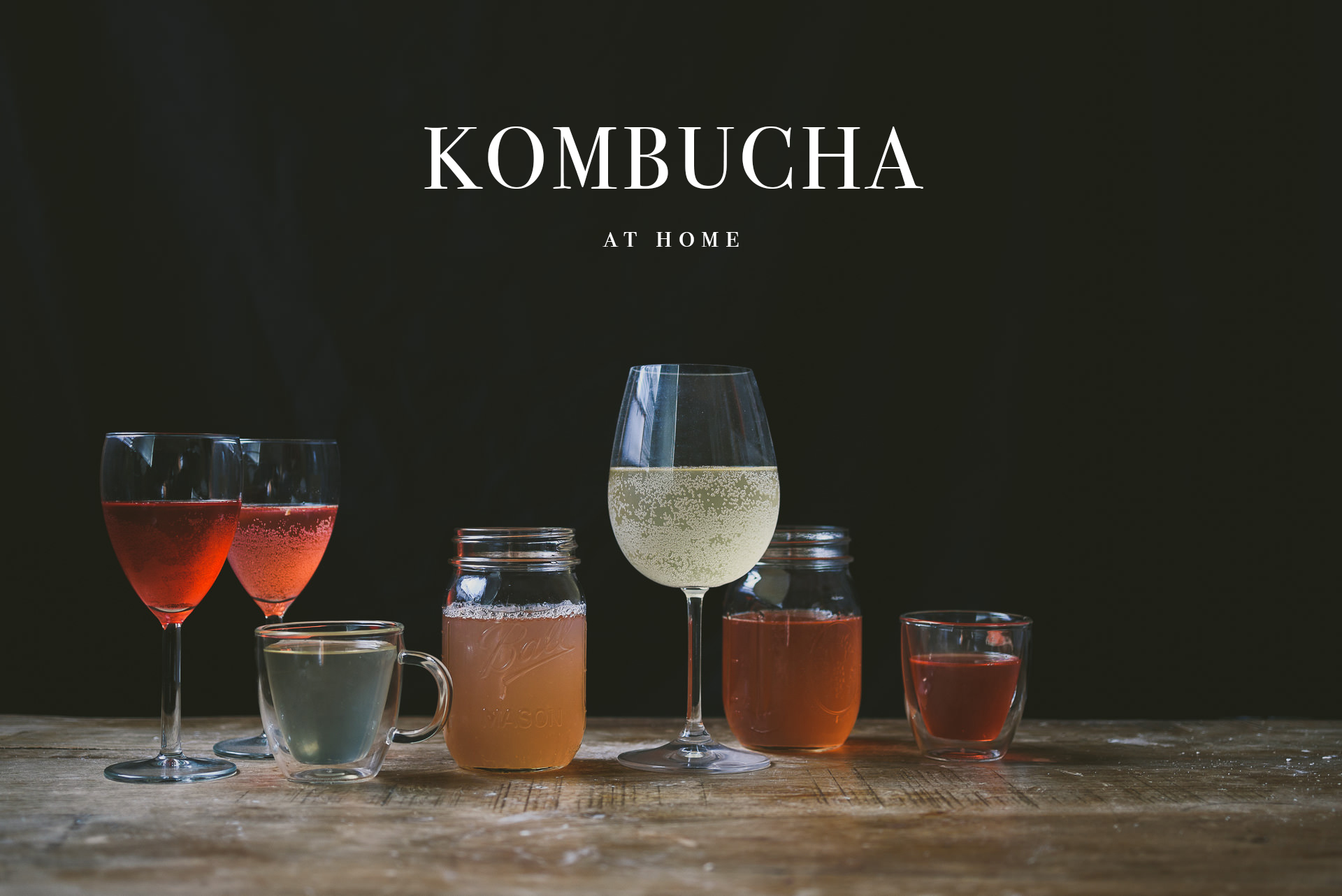
About a month ago, I visited my parents in California. I had a wonderful time with them – we stayed in, ate homestyle Chinese food, and just chatted. For most of my life, my parents were (and still are) the best teachers. I remember distinctly struggling through AP Physics, angrily scratching out free body diagrams because it just didn’t work. My sister and I sat at the table with our papers, calculators, and pencils, and my dad dragged out a white board and began to very patiently explain what it all meant. The textbooks, the teacher’s lectures – none of it did it for me. But my dad’s explanations and live demonstrations somehow perfectly illustrated the concepts of physics. Perhaps it was the focus my dad had on the concepts versus the minute details. I don’t know – but my dad is the best teacher. Anyways, but in the past few years I’ve been able to teach him some things – history of architecture, more Western cuisines, harp technique, etc… and it’s always a privilege to have this in depth conversation where we’re exploring different topics. When I went home last month, I was so eager to talk to him about my newest obsession, fermentation. I’m sure you know where this story is headed, especially if you read the Life and Thyme article I wrote on fermentation and kombucha – my dad’s an EXPERT in fermentation!!!! I was really excited and started describing this cool but at-the-surface gross drink I was brewing, and he was like, Isn’t this hong cha jun?
Apparently, this is something he made with his entire neighborhood during the hot, humid summers in Shanghai. It was a ritual that the community did together – large batches of kombucha would be made, and cold, refreshing kombucha could be distributed to everyone. I knew that kombucha wasn’t a new thing – not by any means. But I think my dad making it when he was a teenager truly underscored the presence of making kombucha through history. You can read my article on the fermentation community in Boston, plus a recipe for blackberry lavender kombucha ice cream float (YUP) here.

This post will be all about kombucha. The drink, the method, and the variations you can use. It can be an intimidating process, but once you get the hang of it and understand the parts of it and why, then you’ll realize that kombucha is actually very intuitive. I have a continuous brew going and have already given out many SCOBY babies for future brews. If you’re in Boston and are interested in brewing kombucha, let me know. I can get a SCOBY baby to you :).
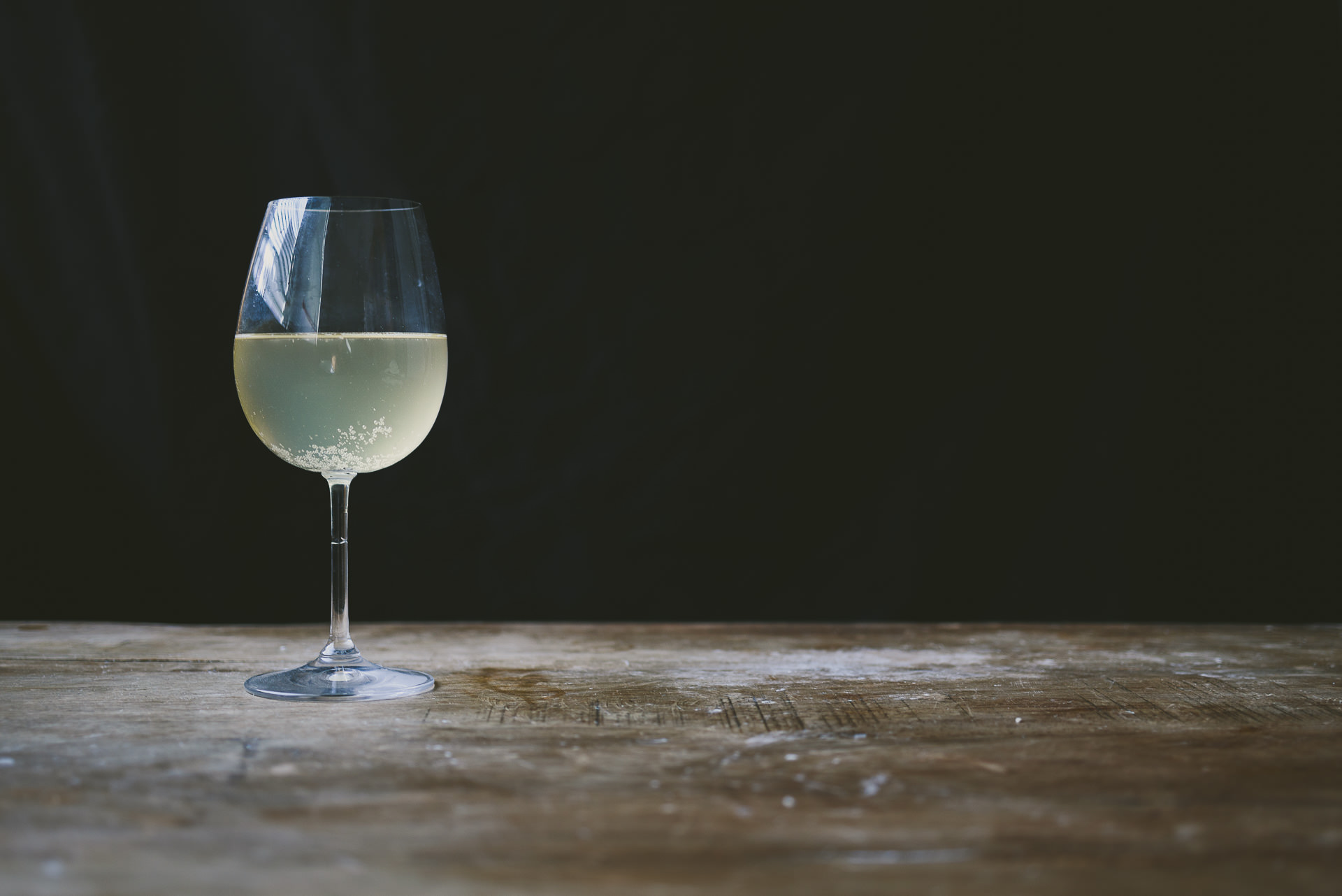 If you’ve been following me on Instagram, you’ll know that I’ve been playing with this gooey looking disk I call a SCOBY, which stands for symbiotic culture of bacteria and yeast. It’s been my recent pet project (literally, the SCOBY is like a pet) and I can’t stop drinking and playing around with kombucha. It’s a wonderful, natural process that produces a refreshingly tangy drink, and the flavor combinations are endless. I’ve been quite obsessed with fermentation lately: my first project was baechoo kimchi, and that was fun to learn about and make. Kombucha is my second one. My third? probably sichuan fermented long beans – actually, my spiced water is now aging nicely in the crock! It’ll be 3 weeks until the final product, but I know it’ll be a good one :).
If you’ve been following me on Instagram, you’ll know that I’ve been playing with this gooey looking disk I call a SCOBY, which stands for symbiotic culture of bacteria and yeast. It’s been my recent pet project (literally, the SCOBY is like a pet) and I can’t stop drinking and playing around with kombucha. It’s a wonderful, natural process that produces a refreshingly tangy drink, and the flavor combinations are endless. I’ve been quite obsessed with fermentation lately: my first project was baechoo kimchi, and that was fun to learn about and make. Kombucha is my second one. My third? probably sichuan fermented long beans – actually, my spiced water is now aging nicely in the crock! It’ll be 3 weeks until the final product, but I know it’ll be a good one :).
My first brush with fermentation actually came through a college course on biochemistry, when I had little to no interest in food. It was very mechanism based and we spent a lot of time going over metabolism. Fermentation is a metabolic process. We learned about anaerobic fermentation on a molecular level and was forced to memorize not only the byproducts and end-products but also the entire pathway. I hardly remember it now, but learning about the fermentation process to make kombucha reminded me strongly of what I learned in biochemistry. It can be summed up as a metabolic process that occurs on a microbial level, through which bacteria or yeast consumes carbohydrates, producing organic byproducts that can be acidic, gaseous, or alcoholic. In kombucha, you get all three. Fermentation in kombucha specifically happens first aerobically, producing acids to get the signature tangy, sharp taste. Then, the resulting brew can be bottled where it will undergo a second fermentation -this time anaerobic – to build up carbon dioxide, obtaining the natural fizz often associated with kombucha. The second fermentation is where you can play with more flavors – fruits, flowers, spices, herbs – whatever you want to add in. The article I wrote for Life and Thyme provided a recipe for blackberry lavender kombucha, and it was lovely. I’ve since used many other types of tea and flavorings.
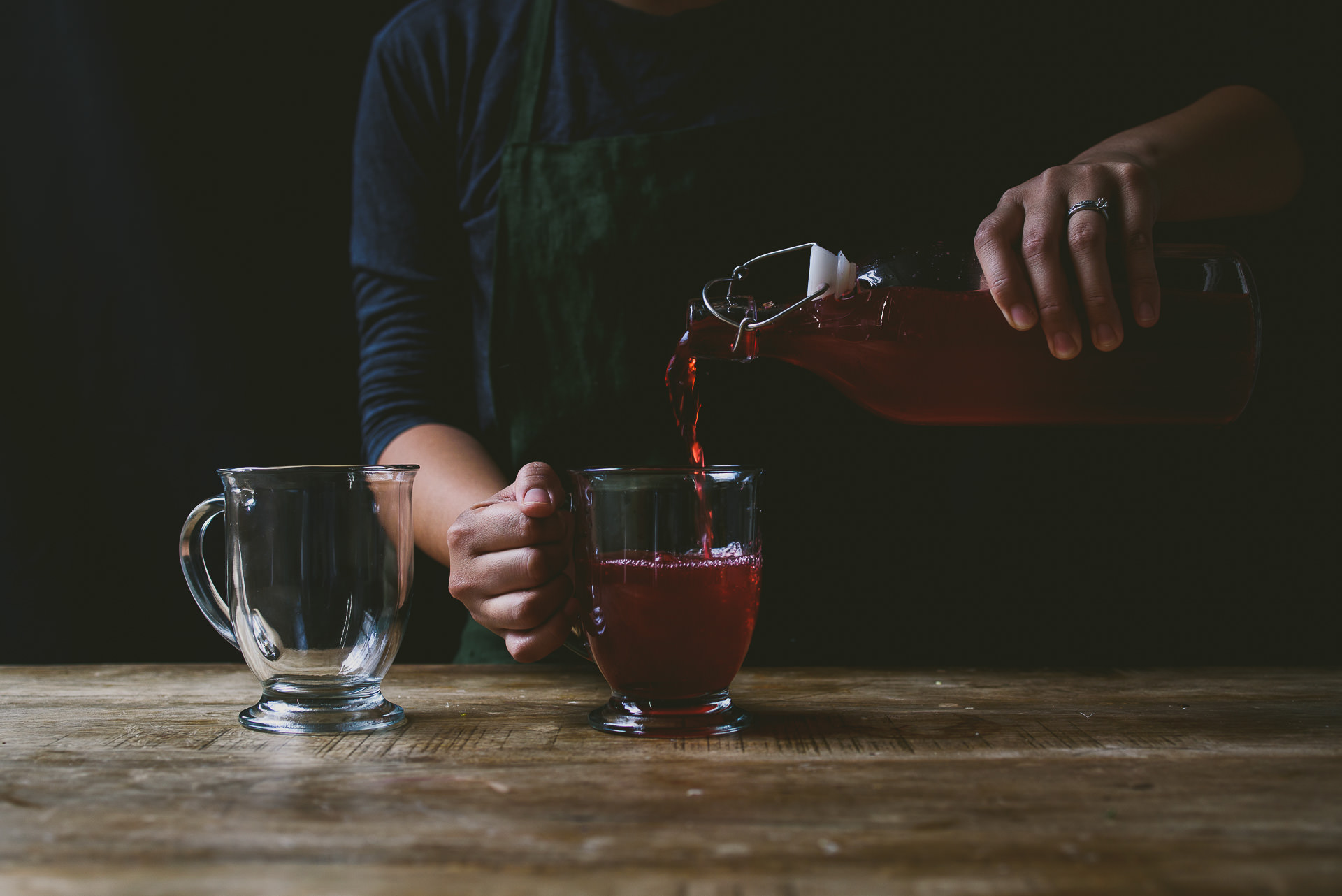
I’ve thought about how I wanted to present this information, and I think by component might be best, so we’ll start with the SCOBY.
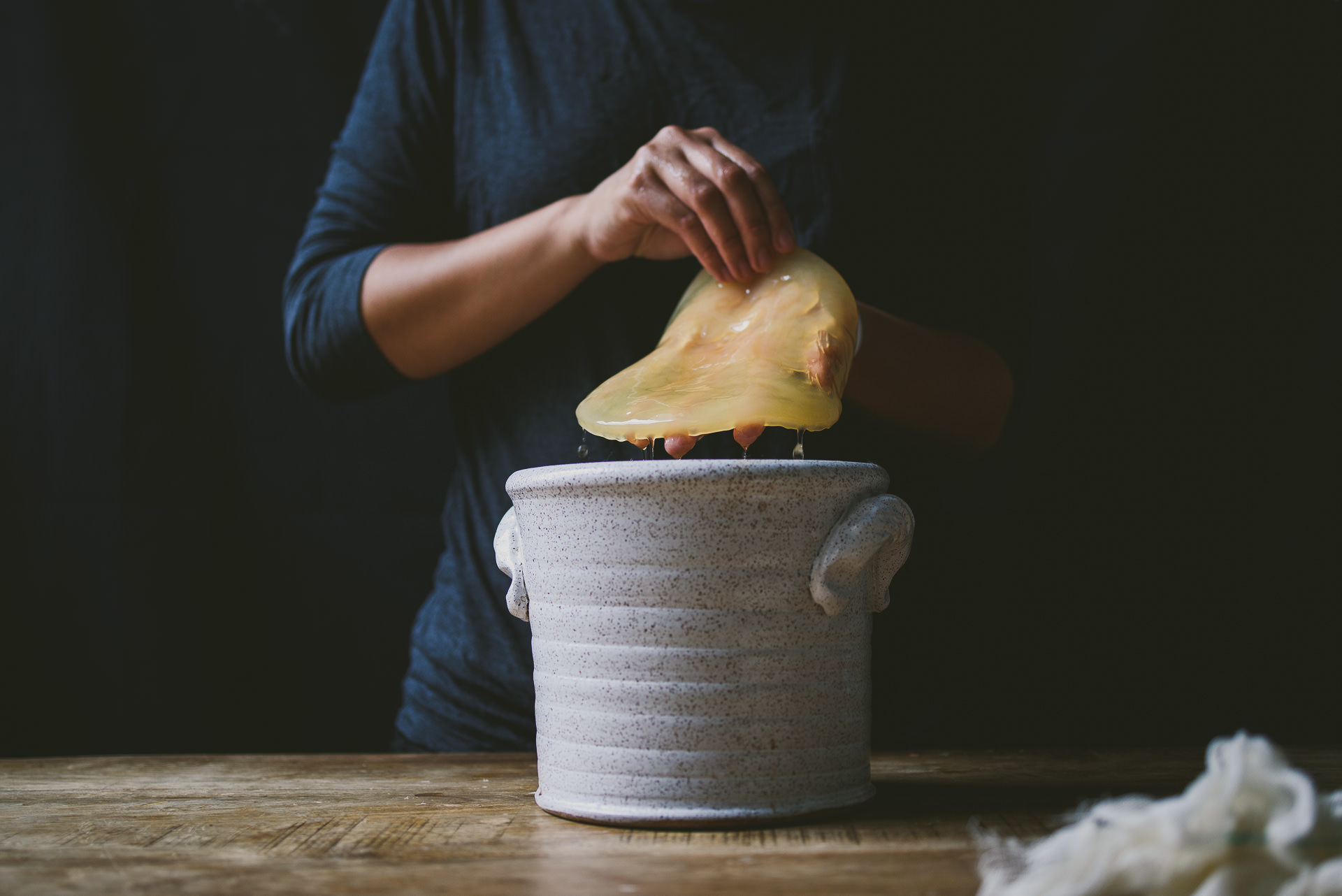
SCOBY
- The SCOBY is the mother. This is the culture of bacteria and yeast that will ferment your sugar and tea. You can get the dehydrated online, but I’d recommend finding someone in your community that can gift you with one. That way you’d have not only the SCOBY but also the starter kombucha tea.
- SCOBY will grow. A healthy SCOBY will grow a “baby” at the top of the brew to the exact fit of the vessel. As you can see in the photos, my small, tiny SCOBY from a mason jar soon grew a “baby” that fit the mouth of my wide fermentation crock. This should happen. Sometimes you will find stringy brown substance clinging to your baby, but that is normal – it is just the natural byproduct yeast. You can strain this out when the time comes. It’s OK if your SCOBY doesn’t float to the top – it can be sideways, tilted, or sink to the bottom. The new “baby” should form at the top of the liquid, but don’t be alarmed if it doesn’t. It will start to form layers. You can literally peel the different layers of SCOBY if you want and grow them in separate mason jars to give away. Culture sharing, after all. You should not see any mold or dry fuzzy patches. You should not see any wiggling movements, which may be fruit fly larvae.
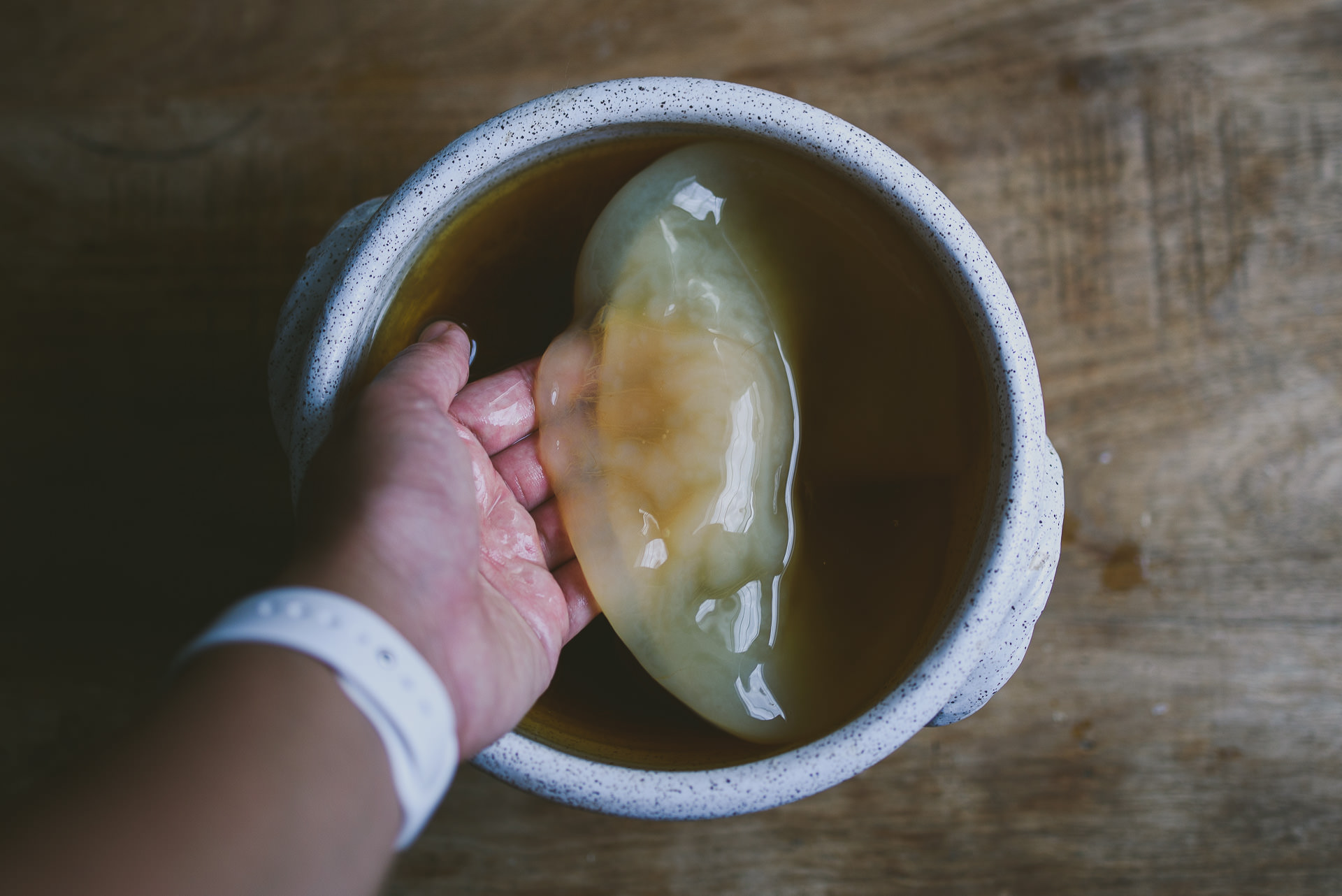
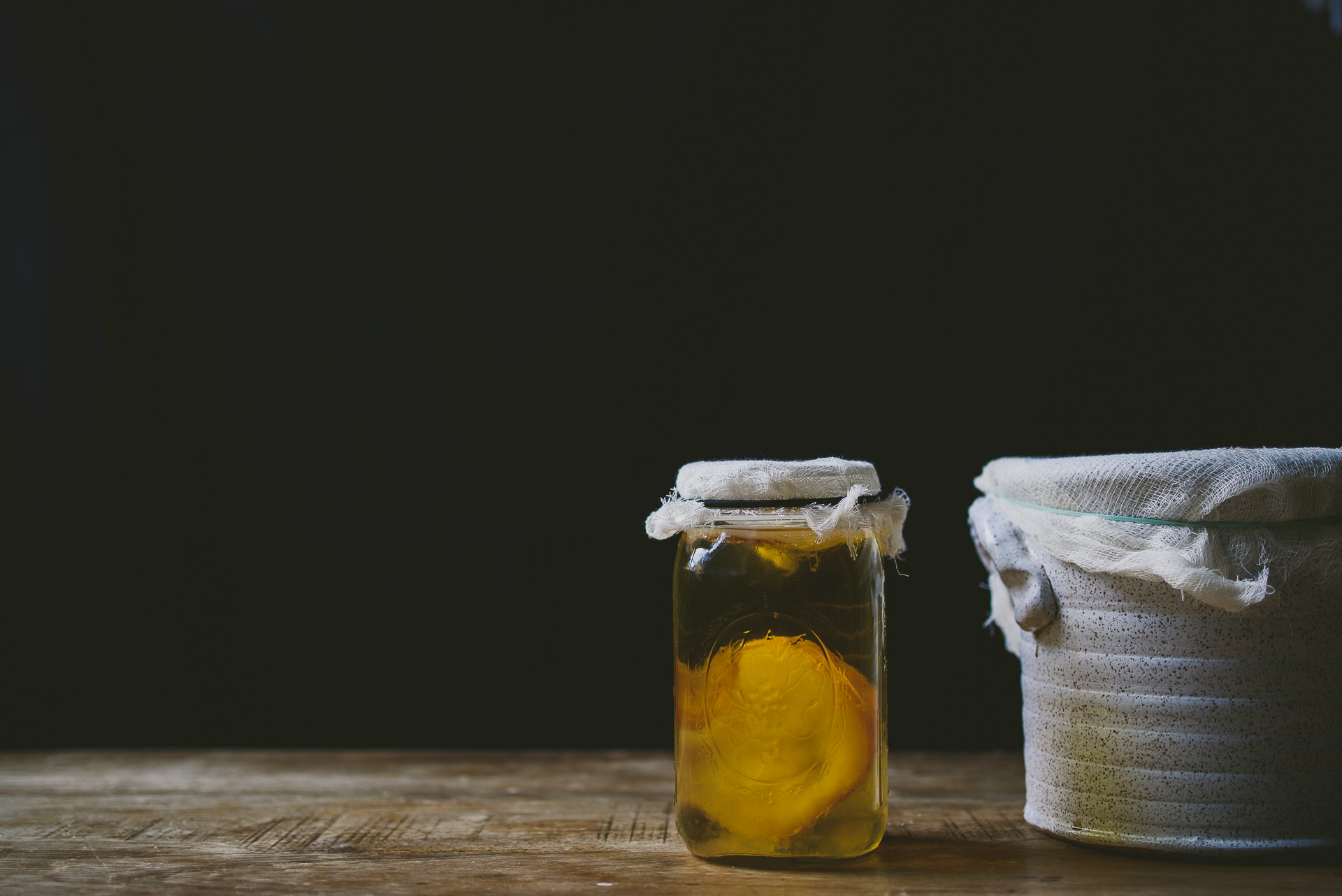
STARTER KOMBUCHA
- Starter kombucha can help bring the acidity of the mixture to a more appropriate level in order for a healthy SCOBY to thrive as well as to keep unwanted bacterias out. As the fermentation process proceeds, the overall acidity of the brew will increase. Sugar is consumed over time with acid as the byproduct, so your brew will increasingly become less sweet and more tangy. It will be up to you if you prefer a more tangy brew or a sweeter one. I start to taste the brew after 6 days to see the level of tanginess.
- About 10% of your brew should be starter tea.
- If you don’t have access to starter kombucha you can use white distilled vinegar, which I used for my first batch actually, since I didn’t have enough starter tea.
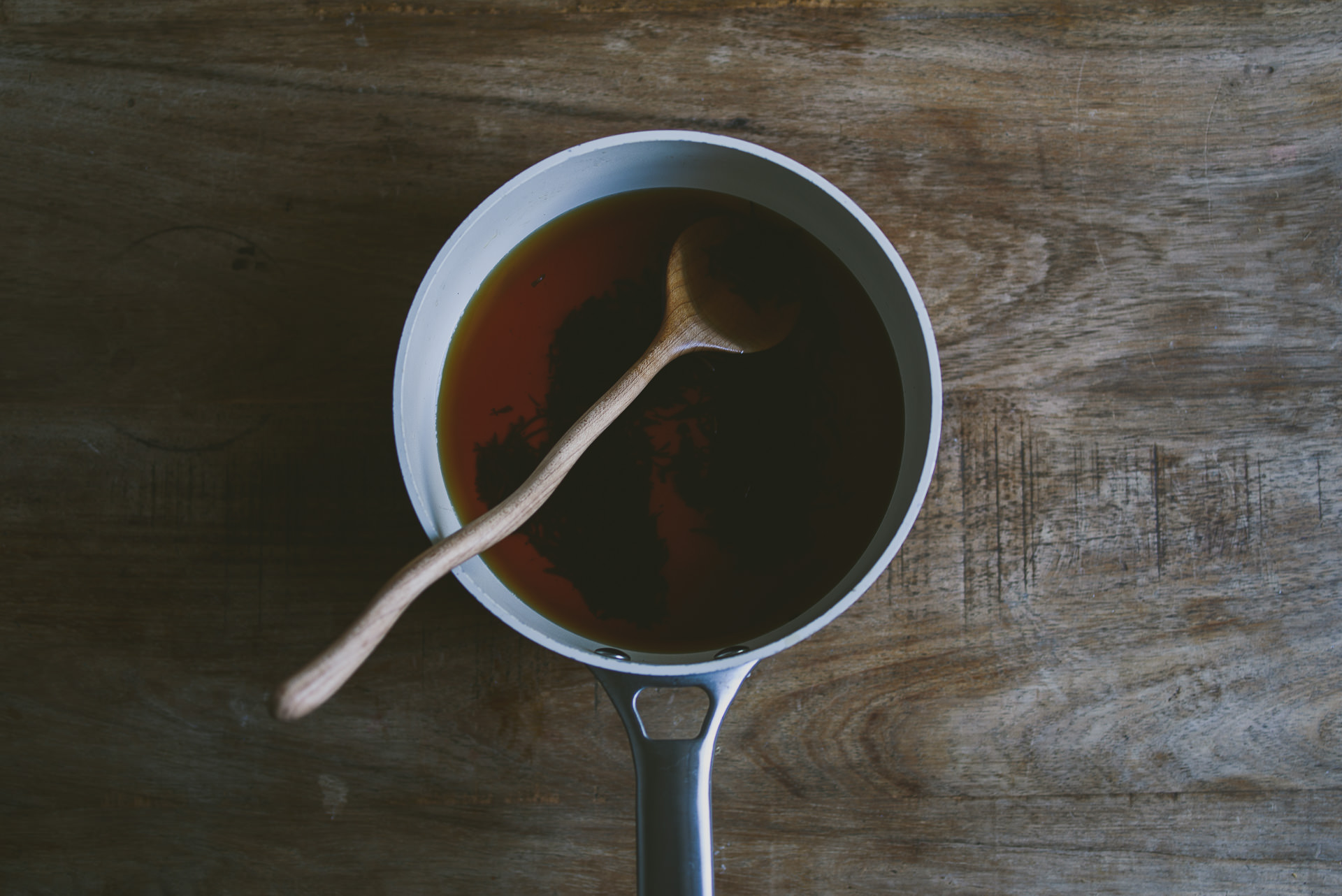
TEA
- I used Chinese black tea, oolong, pu-er, and jasmine green tea with great success. I actually did experiment with a batch using matcha, a powdered green tea, but it didn’t taste good. For all of these teas, the SCOBY babies formed were healthy and thriving. I do not recommend using oiled teas such as earl gray, but I have heard that these work. The important thing about the tea used is that it be of the actual tea leaf from the plant Camellia sinensis. A lot of the teas – black tea, green tea, white tea, etc – are all variations of this plant: picked at different times of the cycle, grown in shade or not shade, fermented, oxidized, etc – if you’ve ever been to a tea room in Asia you’ll know just how varied teas can be. This website is a fantastic resource for different types of teas and notes associated with them. I prefer a stronger brew of tea, so I used loose leaf tea, although tea bags will work as well.
- The water you use to brew the tea should be pure water. I know people who have done it with normal tap water with no problems, but I just bought a gallon of pure water just in case.
- Add the SCOBY only after the tea leaves (and any metal strainers) are removed and the brew has cooled to room temperature. A too warm environment can kill off your SCOBY. One trick I use is to brew a small, concentrated batch of about 3 cups of tea, then dilute it with the rest of the water at room temperature. This can bring the temperature down rapidly. I then it it steep, covered for at least 15 minutes, and then until room temperature.
SWEETENER
- Cane sugar is used, but apparently what is known as “jun” is honey-sweetened kombucha. I was at first confused because in Chinese, kombucha is referred to as “hong cha jun”, 红茶菌, which literally translates to black tea mushroom. I assumed jun was just kombucha. I’ll have to do more research into this – much gets lost in translation, after all. I’d like to try using honey one day.

VESSEL
- Choose a wide mouthed vessel made of glass, ceramic (no lead), or stainless steel. Plastic is not recommended due to some unsavory tastes, but I’ve not used it myself. I use a ceramic fermentation crock gifted to me by Jeremy. It has a beautifully wide mouth perfect for kombucha. The initial fermentation requires constant aeration, so maximum surface area to volume ratio would be optimal. Air is a friend, so let’s try to give the SCOBY maximum surface area.
- The cover should be a tightly woven, porous surface. I use many layers of cheesecloth, but I’ve heard from others that it can still allow fruit flies to get in. While I’ve never had a problem using cheesecloth, this does worry me so I’ve since switched to using simple tea towels as a cover. I’d recommend being on the safe side and using a tighter weaved cloth.
- Always, always sanitize everything with a NON antibiotic soap and hot water. You can also rinse everything with white distilled vinegar.
- Store away from direct sunlight.
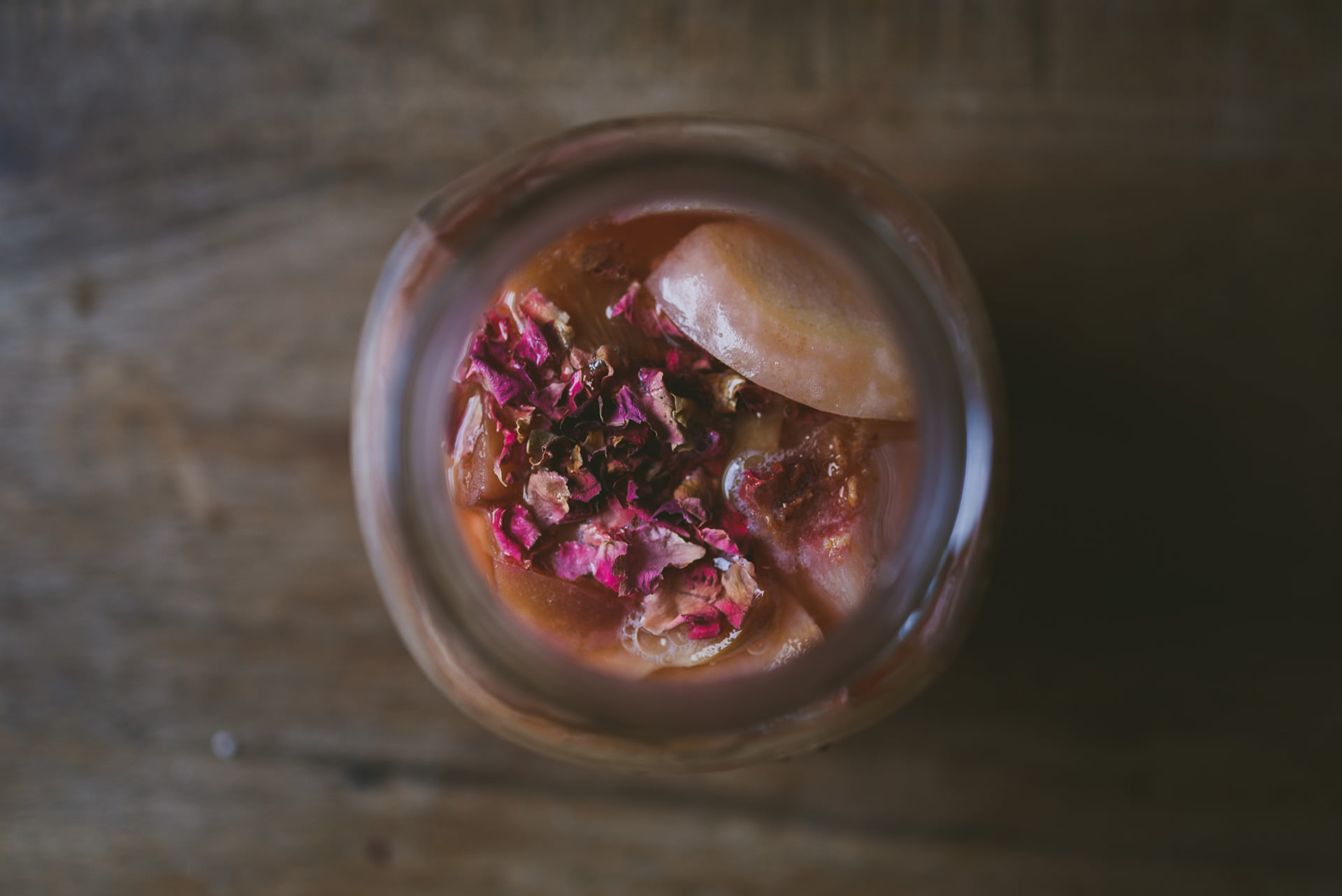
SECOND FERMENTATION
- This is your blank canvas. You’ve chosen your tea, and now you can play with the flavors.
- The sweeter the additions, the faster the ferment, which means faster build up of carbonation. To prevent any possibilities of explosion, let the kombucha “burp” once a day, or every other day. I’ve only heard of kombucha explosion once -but she let it go in the basement for 11 days without burping. I let this go for about 5 days, with burping and I got some great carbonation. In fact, I open the resulting kombucha over the sink sometimes, because it will spew out like opening a bottle of champagne.
- Don’t use a metal lid, because the acidic brew will react with metal. I recommend flip-top brewing bottles.
- Some great combinations
- blackberry lavender
- peach rose
- peach with oolong tea
- ginger carrot
- pineapple ginger (this is my favorite)
- apple cinnamon
- plum, by itself
- strawberry basil
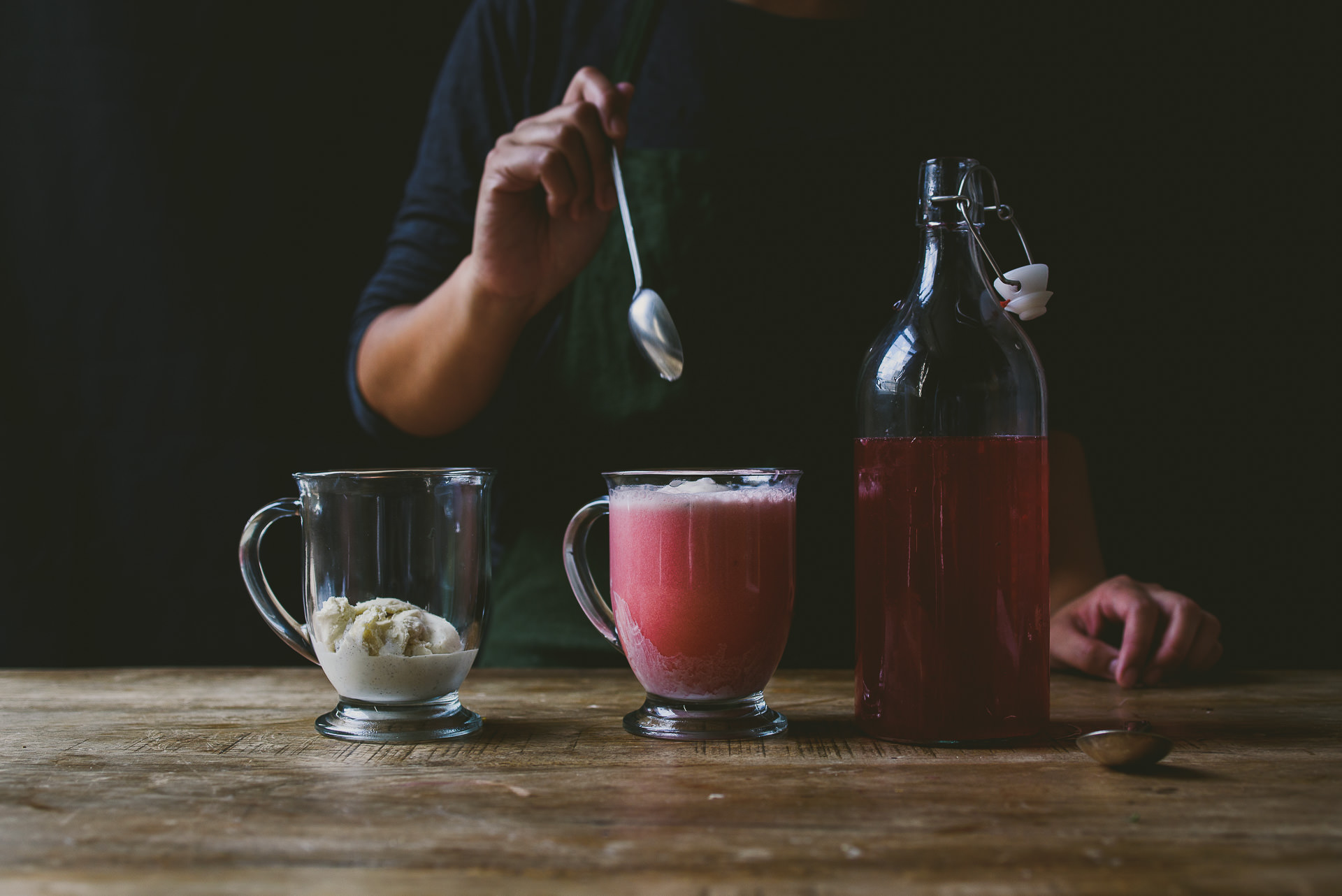
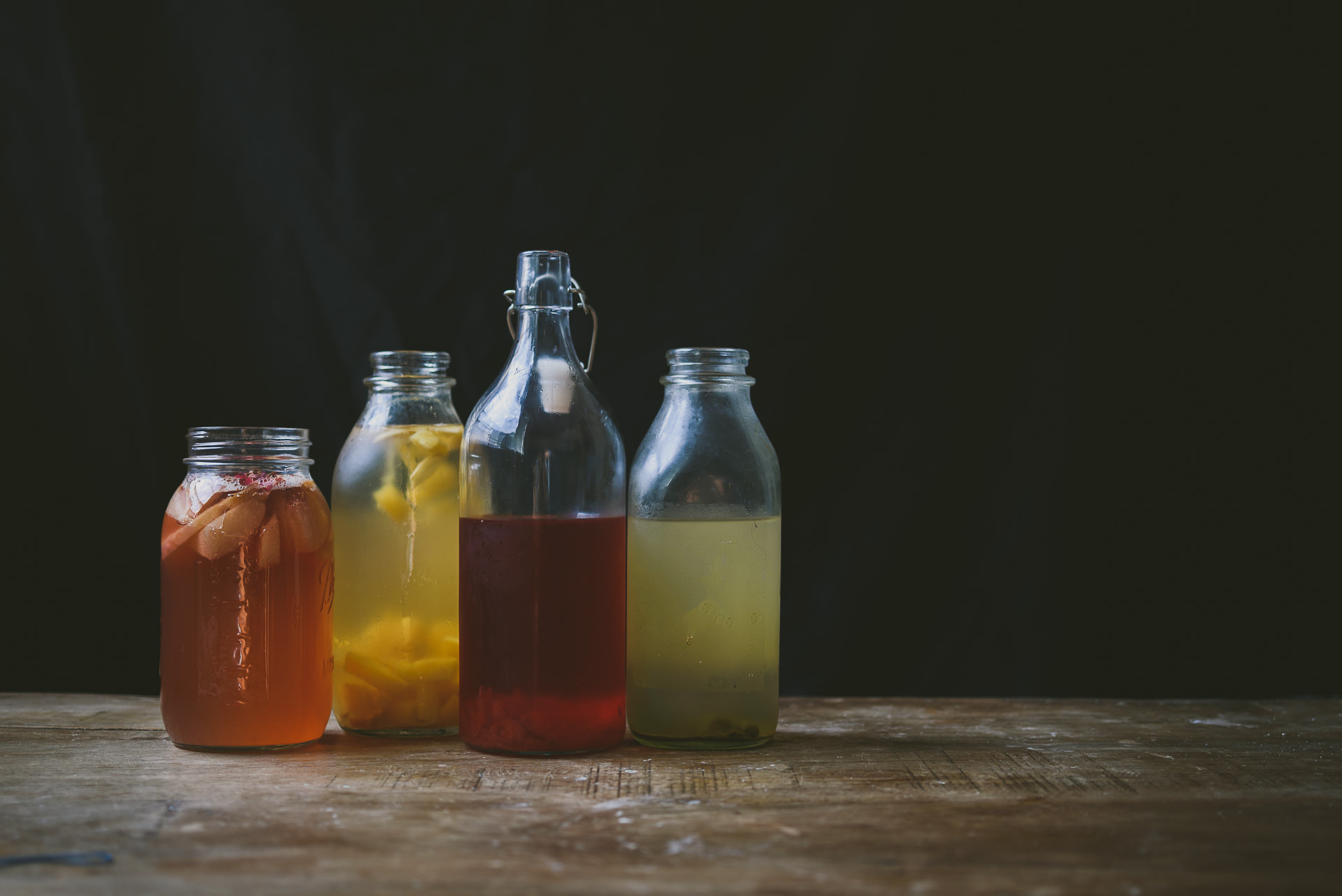
NOTES
- When brewing a new batch of kombucha, I always reserve a “safety” SCOBY – you should be able to easily peel layers away. I use one for my big brew, and another with some fresh sweet tea in a smaller jar, just in case
RECIPE: KOMBUCHA
Ingredients
3 + 7 cups pure water, separated
3 tablespoons loose leaf tea (or equivalent in tea bags, about 7-8 bags)
1 cup sugar
1 cup starter kombucha or distilled white vinegar
SCOBYSample 2nd fermentation:
1/3 cup chopped peaches
1 tbsp dried rose
1| Prepare sweet tea: Bring 3 cups of water to a boil. Add 1 cup sugar and stir until dissolved. Turn off heat. Place tea strainer in and let steep for 5 minutes. Then, add in the remaining pure water and let cool to room temperature. Leave tea leaves in as the sweet tea cools.
2| Remove strainer and add sweet tea to fermentation vessel.
3| With clean hands, gently slide SCOBY to the top of the crock. If it sinks, don’t worry about it.
4| Cover jar with layers of porous material and rubber band it tightly.
5| Place brew in a warm corner away from direct light and away from other fermentation vessels.
6| Ferment for 7-10 days. At day 7, taste the brew. The longer the ferment, the more tangy your brew will taste. Kombucha should be tart and sweet.
7| Second ferment: Pour brew into glass jars with airtight lids and seal with secondary flavoring for another 2-5 days. Let burp once a day to prevent drastic pressure buildup.
8| When kombucha is flavored and fizzy enough, transfer to the fridge. Serve after straining.
And.. puppy photobomb!!!
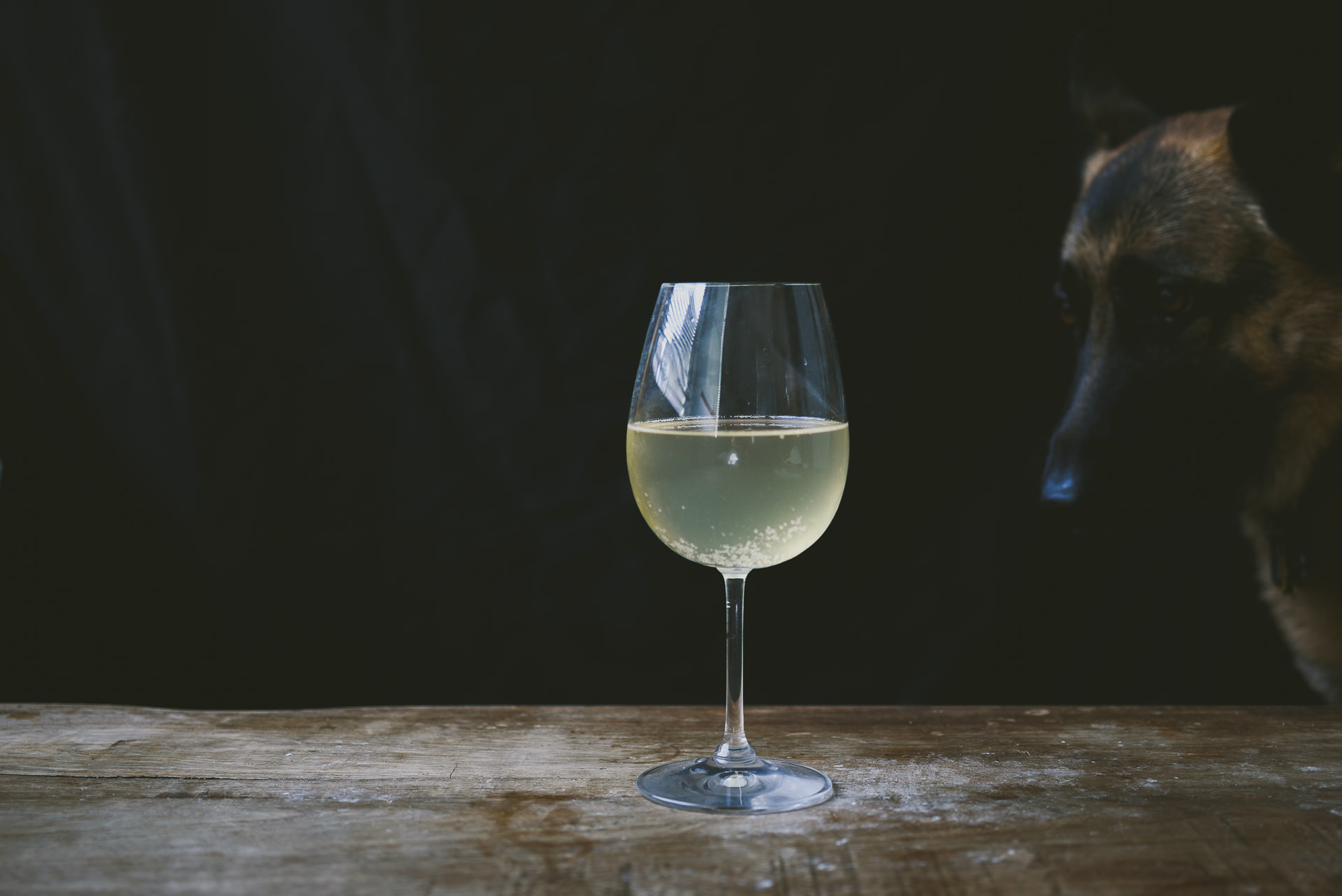

i want your Scoby!! Haha. yea now that I think about it, there’s so many different fermented drinks in Asia. I love love Korean malted rice drink which is kind of a dessert that we used to make all the time. This post was so informative Betty!!! <3
Ah thanks for reading Mabel! <3
never took ap physics, but i remembering plenty of complaints and curses about it. and wow- i’m surprised that kombucha is a chinese thing (i also don’t know much about it, and drink it in ignorant bliss).
When I was taking it I could’ve complained all day. I was totally surprised kombucha was a Chinese thing too! I knew it was an age-old method but I was shocked when my dad knew exactly what it was. I did some more research and it apparently did originate in China. People have been drinking it there as a medicinal drink for thousands of years!
So lovely to read about your father and his making of kombucha in Shanghai! I spent the better part of a year in China a while back and if I could I absolutely would have stayed longer. By far my favourite place to travel. I love kombucha, I have been home brewing for two years and it’s just so rewarding! You should give mushroom tea a try! I’ve had great success with a mostly Chaga reishi blend with a touch of green tea! I’ve never had a kombucha explosion but I have certainly come home to a ceiling bathed in coconut kefir! xx
Oh I’m so glad you liked China!!! I wish I could go back more frequently – isn’t it just so diverse and crazy?! I have heard of Chaga tea – in fact a mushroom forager I connected with recently just found some wild chaga and was telling me about it. I guess I must try it now :). I want to try making kefir next!!
Betty this was so incredibly informative and well-written, I never really considered doing it but now I really want to try (maybe when I have a solid stretch of time when I’m not traveling so I can baby the little SCOBY child)!!
I also just tried pu’er for the first time and I think it would make some wonderful, more assertive type kombucha. Like the IPA of kombucha 🙂
Oh Joyce, you read my mind!! I just got my hands on a good disc of pu-er and that’s what I’m going to try next! I’ll report how it is :). I’ve read online that pu-er kombucha is particularly soothing because of the medicinal effects of the tea, but we’ll see!!!!
Thank you for the information about kombucha. I have a scoby from a friend, and I want to learn how to make kombucha. I appreciate your in-depth post, and I hope to make kombucha soon.
Yay!! Have tons of fun <3.
Hi Betty,
I have a question about adding fruit during the second ferment. Do you just add whole fruit (or chunks) and/or herbs or do you add the juice of the fruit? If it’s whole, do you strain after the second fermentation is done?
Thanks so much for this lovely post!
Cheers,
Maureen
Hi Maureen,
I do both – sometimes I crush up the fruit a bit and then add it like I did with blackberries, but with peaches I added chunks. I’ve heard that you can use ONLY fruit juice as well, but I haven’t trie sit that way. I do strain it after it is done :).
Betty
Thanks so much, Betty. I have not had much luck gaining the carbonation on the second fermentation, but I haven’t tried adding fruit, so will give it a go!
such a wonderful post dear betty!! and these pictures are stunning<3
Thanks ladies 🙂 <3.
I love drinking kombacha but have been apprehensive about making my own. Your post was incredibly enlightening and I am preparing to try it myself! Thanks also for the tidbit about your dad and the science you included. And, the photos are beautiful.
Thank you Julie!!!!!
You are so rad for having done this – so so rad. Love the story about your pops too! I will need to give this a try someday, if for no other reason than to make your genius kombucha ice cream float! (Seriously that was brilliant!)
SO COOL and weird at the same time! I love kombucha, but I never really knew how it was made. I want a kombucha ice cream float NOW
your post has brought back fond memories of my asian father teaching me ap bio – he was eons better than my actual teacher :’)
and wow, that scoby looks so slimy but so awesome, like some kind of giant jellyfish! thank you for the detailed tutorial – especially the fruit additives in the second ferment. i never knew that’s how they got the flavor into the kombucha – looking forward to trying as soon as i find a scoby
AMAZING. I’m obsessed with this, Betty. Adore the depth of your connection to the process and how crazy-mazing informative this is. I want to share this with a million folks and start a kombucha revolution. Well, have you start a kombucha revolution. LOL.
Yayayay! I love finally seeing posts I’ve been excited for ever since you sneak-peeked it on Instagram 😀
p.s. Annie is me staring in awe at these gorgeous photos (except through a computer screen)
Hi Betty! I don’t have a SCOBY or access to one because kombucha hasn’t caught on much in Kuwait, where I live. I found a supermarket that sells equinox brand kombucha so I decided to grow a SCOBY myself. I made it yesterday and fingers crossed, it’ll grow into a beautiful one like yours.
I wanted to ask, after the second fermentation, how long does the kombucha last in the fridge? The store bought one lasts about 8 months but just wanted to ask you and what you recommend. Also, do I need to strain after the second fermentation or is it fine to refridgerate with the fruit the bits in? Can we eat the fruits we use during the second fermentation?
Sorry I’m asking so many questions but I’m totally new to kombucha ^_^
I love kombucha! I was able to find a local place that could mail me a SCOBY and a cup of starter tea and I have been brewing my own kombucha for almost a year now, and I love it! So simple, so delicious, and I really do feel better when I drink it regularly.
One question I have is about the alcohol content: I have heard that it is impossible to make kombucha without alcohol unless you skip the second fermentation – do you have any info on that that you could share?
My husband started to drink Kombucha instead of beer for months, and he felt great! We buy Kombucha from Whole Foods regularly, but it will be even better if I can make it for us!!! Could you let me know how to get your SCOBY? I live in Boston now, and I am also from Shanghai. :)))))
I went to first grande in Shanghai in 1948. My friend introduced Kombucha to me. Originally she told me for better look. I liked it. Her friend’s husband has glaucoma and was operated on one eye. Doctor advised him to go back half year later to operate on his 2nd eye. When he went back to the doctor, his doctor reexamined his other eye and told him no need to do operation. He examined what he did different from his usual life. It was drinking Kombucha. This is after I told her my diabetes improved. You still have to watch out what you eat. I think the Kombucha’s alive yeast helped in digest system that helped improving our body. I sent some scoby pieces to my sister in Boston recently. Hope she makes it accordingly and grow more scoby to share. I did not taste alcohol in it. There are jars over 2 months. It became so super sour. I drink some plain water before drinking the mix to avoid damaging my teeth and stomach. I pour some in sweet drink to drink and rinse mouth after drinking. You can put dried fruits such as guey-yuan meat and go-zi for their extra fragrance and nutrients. Fresh fruits make the liquid not clear. You can do it too.
Hi Betty
Interesting to know that your father made kombucha in Shanghai. Your photos are beautiful!
But I would like to say that I have read in may places that you should NOT add vinegar when growing kombucha – you might end up with something gross called “vinegar eels.” Ewww!
I have been making jun, with honey and green tea, for several weeks now. I live in Canada, so I ordered the jun scoby from a business in Saskatchewan. While i would like to make kombucha, the jun tastes great and it grows faster, too, so maybe I will just stick with jun for now. We are supposed to use raw honey, though….since that costs more than sugar my hobby might become too expensive eventually.
I have been making kombucha for 3 years. How much do you say you should consume in a day.
“hong cha jun”, 红茶菌, which literally translates to black tea mushroom
Actually, I think “hong cha” means red tea. If I remember colors correctly…
Thank you for your comment. The character by itself means red, you are correct, but “hong cha” refers to black tea.
“红” actually means “red” so 红茶菌 (Hong Cha Jun) is a “red tea fungus”.
As I am only familiar with using honey I really enjoy your beautifully written article.
The microwave is my favorite way to disinfect. Although I understand the damaging effect a microwave has on food/ body etc. It’s a very clean and safe tool for glass, cloth, plastic etc. I simply put freshly rinsed equipment still wet into microwave and let go a minute or two.
Kills every single microorganism at an impressive temperature without the use of antibacterial soaps which you don’t want anywhere near your scobi.